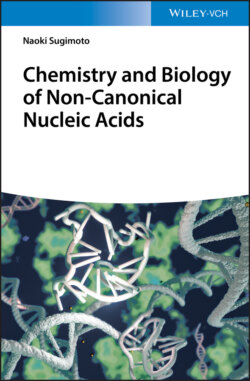Читать книгу Chemistry and Biology of Non-canonical Nucleic Acids - Naoki Sugimoto - Страница 12
1.2 History of Duplex
ОглавлениеThe opening of the history of genetics was mainly done by three researchers. Charles Robert Darwin, who was a scientist of natural science, pioneered genetics. The proposition of genetic concept is indicated in his book On the Origin of Species published in 1859. He indicated the theory of biological evolution, which is the basic scientific hypothesis of natural diversity. In other words, he proposed biological evolution, which changed among individuals by adapting to the environment and be passed on to the next generation. However, that was still a primitive idea for the genetic concept. After that, Gregor Johann Mendel, who was a priest in Brno, Czech Republic, confirmed the mechanism of gene evolution by using “factor” inherited from parent to children using pea plant in 1865. This discovery became the concept of genetics. At the almost same time in 1869 as Mendel, Johannes Friedrich Miescher, who was a biochemist in Swiss, discovered nucleic acids as a chemical substance of the gene identity. He named it “nuclein” (later, it was named “nucleic acid,” which exists acidic substance in nucleus) and made the opportunity to study nucleic acid chemistry. However, it would be doubtful if he realized that nucleic acid is the gene identity. After that, it was needed to take a lot of time to conclude that the gene identity is proved the chemical substance.
Charles Robert Darwin (left), Gregor Johann Mendel (middle), and Johannes Friedrich Miescher (right)
Erwin Rudolf Josef Alexander Schrödinger, who was a great physicist, pioneered to go after the mystery of gene. He published a book titled What Is Life? in 1944 [1]. This book invited the study of the gene to many researchers. He mentioned in the book that he believed a gene – or perhaps the whole chromosome fiber – to be an aperiodic solid, although he also mentioned that gene is probably one big protein molecule. After the 1950s, chemistry regarding nucleic acids had been developing. One of the organic chemists was Erwin Chargaff, who was a professor at Colombia University in the United States and born in Austria. He discovered that from the result of paper chromatography targeted to the different types of DNA, the number of guanine units equals the number of cytosine units and the number of adenine units equals the number of thymine units [2]. It is called Chargaff's rules. On the other hand, analysis of the superstructure of nucleic acids was also proceeding. At the beginning of the 1950s, at King's College London, the results of X-ray crystal analysis were accumulated by Maurice Hugh Frederick Wilkins, Rosalind Elsie Franklin, and others. Finally, based on their result, Watson and Crick who worked at Cavendish Laboratory in Cambridge and proposed the model of double helix structure of DNA (Figure 1.1 and see Chapter 2), published as a single-page paper about DNA double helix in Nature issued on 25 April 1953 [3]. By discovering DNA double helix structure, Watson, Crick, and Wilkins were awarded the Nobel Prize in Physiology or Medicine in 1962.
Figure 1.1 The diffraction pattern of the canonical DNA duplex and its chemical structure.
Source: Kings College London.
Erwin Rudolf Josef Alexander Schrödinger (left) and Erwin Chargaff (right)Maurice Hugh Frederick Wilkins (left) and Rosalind Elsie Franklin (right)James Dewey Watson and Francis Harry Compton Crick
